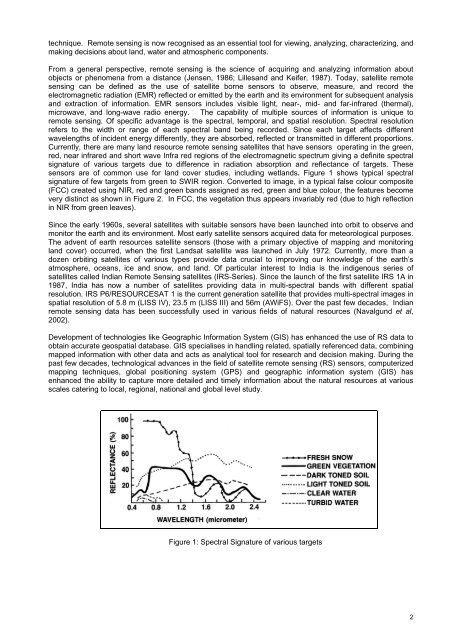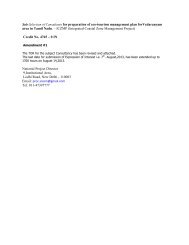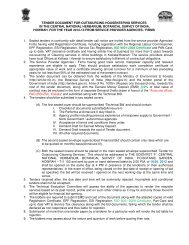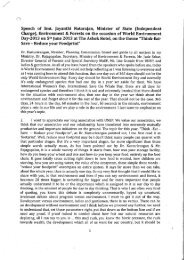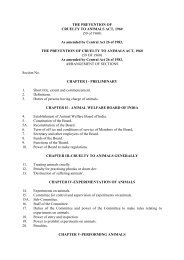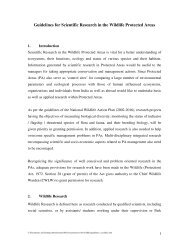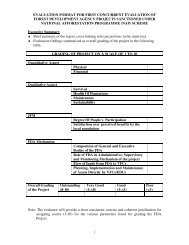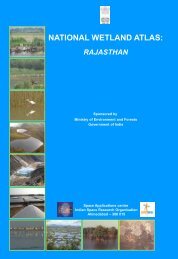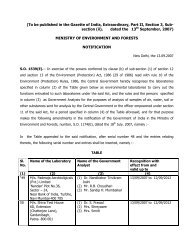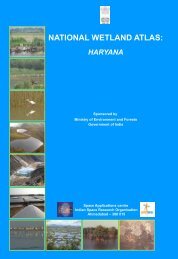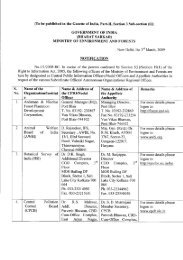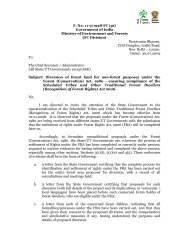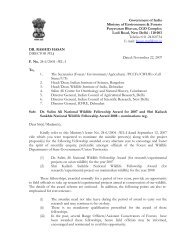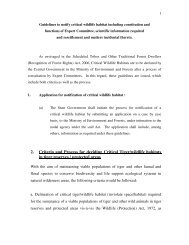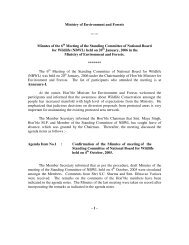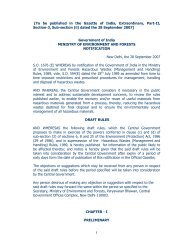Assam - Ministry of Environment and Forests
Assam - Ministry of Environment and Forests
Assam - Ministry of Environment and Forests
You also want an ePaper? Increase the reach of your titles
YUMPU automatically turns print PDFs into web optimized ePapers that Google loves.
technique. Remote sensing is now recognised as an essential tool for viewing, analyzing, characterizing, <strong>and</strong>making decisions about l<strong>and</strong>, water <strong>and</strong> atmospheric components.From a general perspective, remote sensing is the science <strong>of</strong> acquiring <strong>and</strong> analyzing information aboutobjects or phenomena from a distance (Jensen, 1986; Lilles<strong>and</strong> <strong>and</strong> Keifer, 1987). Today, satellite remotesensing can be defined as the use <strong>of</strong> satellite borne sensors to observe, measure, <strong>and</strong> record theelectromagnetic radiation (EMR) reflected or emitted by the earth <strong>and</strong> its environment for subsequent analysis<strong>and</strong> extraction <strong>of</strong> information. EMR sensors includes visible light, near-, mid- <strong>and</strong> far-infrared (thermal),microwave, <strong>and</strong> long-wave radio energy. The capability <strong>of</strong> multiple sources <strong>of</strong> information is unique toremote sensing. Of specific advantage is the spectral, temporal, <strong>and</strong> spatial resolution. Spectral resolutionrefers to the width or range <strong>of</strong> each spectral b<strong>and</strong> being recorded. Since each target affects differentwavelengths <strong>of</strong> incident energy differently, they are absorbed, reflected or transmitted in different proportions.Currently, there are many l<strong>and</strong> resource remote sensing satellites that have sensors operating in the green,red, near infrared <strong>and</strong> short wave Infra red regions <strong>of</strong> the electromagnetic spectrum giving a definite spectralsignature <strong>of</strong> various targets due to difference in radiation absorption <strong>and</strong> reflectance <strong>of</strong> targets. Thesesensors are <strong>of</strong> common use for l<strong>and</strong> cover studies, including wetl<strong>and</strong>s. Figure 1 shows typical spectralsignature <strong>of</strong> few targets from green to SWIR region. Converted to image, in a typical false colour composite(FCC) created using NIR, red <strong>and</strong> green b<strong>and</strong>s assigned as red, green <strong>and</strong> blue colour, the features becomevery distinct as shown in Figure 2. In FCC, the vegetation thus appears invariably red (due to high reflectionin NIR from green leaves).Since the early 1960s, several satellites with suitable sensors have been launched into orbit to observe <strong>and</strong>monitor the earth <strong>and</strong> its environment. Most early satellite sensors acquired data for meteorological purposes.The advent <strong>of</strong> earth resources satellite sensors (those with a primary objective <strong>of</strong> mapping <strong>and</strong> monitoringl<strong>and</strong> cover) occurred, when the first L<strong>and</strong>sat satellite was launched in July 1972. Currently, more than adozen orbiting satellites <strong>of</strong> various types provide data crucial to improving our knowledge <strong>of</strong> the earth’satmosphere, oceans, ice <strong>and</strong> snow, <strong>and</strong> l<strong>and</strong>. Of particular interest to India is the indigenous series <strong>of</strong>satellites called Indian Remote Sensing satellites (IRS-Series). Since the launch <strong>of</strong> the first satellite IRS 1A in1987, India has now a number <strong>of</strong> satellites providing data in multi-spectral b<strong>and</strong>s with different spatialresolution. IRS P6/RESOURCESAT 1 is the current generation satellite that provides multi-spectral images inspatial resolution <strong>of</strong> 5.8 m (LISS IV), 23.5 m (LISS III) <strong>and</strong> 56m (AWiFS). Over the past few decades, Indianremote sensing data has been successfully used in various fields <strong>of</strong> natural resources (Navalgund et al,2002).Development <strong>of</strong> technologies like Geographic Information System (GIS) has enhanced the use <strong>of</strong> RS data toobtain accurate geospatial database. GIS specialises in h<strong>and</strong>ling related, spatially referenced data, combiningmapped information with other data <strong>and</strong> acts as analytical tool for research <strong>and</strong> decision making. During thepast few decades, technological advances in the field <strong>of</strong> satellite remote sensing (RS) sensors, computerizedmapping techniques, global positioning system (GPS) <strong>and</strong> geographic information system (GIS) hasenhanced the ability to capture more detailed <strong>and</strong> timely information about the natural resources at variousscales catering to local, regional, national <strong>and</strong> global level study.Figure 1: Spectral Signature <strong>of</strong> various targets2


